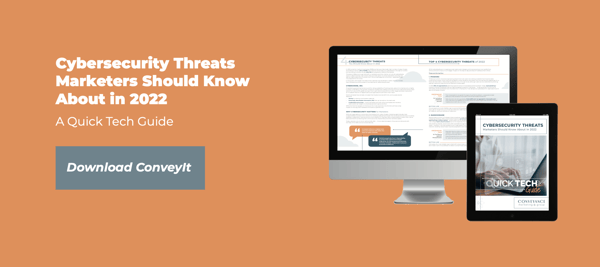 Last week, we talked about the value of data, and mentioned that many businesses have more of it than they know what to do with. This problem is recognized by 87% of marketers who say data is the most underutilized asset within their organization. Consequently, there’s a big market for solutions that promise to make data work harder, and the Customer Data Platform (CDP) is one of them.
Last week, we talked about the value of data, and mentioned that many businesses have more of it than they know what to do with. This problem is recognized by 87% of marketers who say data is the most underutilized asset within their organization. Consequently, there’s a big market for solutions that promise to make data work harder, and the Customer Data Platform (CDP) is one of them.
According to Gartner blogger Martin Kihn, “No marketing tech in recent memory has shot up the hype curve so far, so fast, as the customer data platform (CDP)”. While CDPs or CDP-like products have been around for a long time, they achieved a burst of publicity in 2017 when the number of CDPs rose by 59%.
Since then, CDPs have achieved rapid growth, with estimates projecting that the market will reach $3.3 billion by 2023. As the end of the year approaches, businesses are already budgeting for 2020. But should they add CDP to their list of projects? In this article, we’ll answer that question, beginning with an explanation of CDP and what it does.
What is Customer Data Platform (CDP)?
For years, digital-dependent businesses have been collecting data on their customers and using it to shape everything from advertising to communication and web design. The systems behind this collection, storage and personalization vary from company to company, requiring a lot of back end work and development.
CDP consolidates all this functionality in an out-of-the box solution. It identifies and tracks both known customers and anonymous prospects across the web using a variety of data sources, collecting it into a centralized location that can be used to tailor marketing for individuals and audience segments.
CDP is related to and sometimes confused with CRM. While the two technologies complement each-other, there are differences in focus and functionality. For instance,
- In addition to tracking known customers, CDP gathers information on anonymous web visitors in the discovery phase, providing a data-rich profile that can be used to streamline marketing efforts
- The range of data collected by CDP is broad in scope, tracking lifetime behavior and journeys that extend beyond the sales funnel to provide a more robust customer profile than CRM
- Unlike CRM, CDP retains granular data for the long-term in a central repository
- CRM typically requires manual input, while CDP collects data automatically
In short, CDP is all the “creepy” parts of online marketing in a box. Its value is primarily derived from the way it is used to bolster data-dependent applications like targeted advertising, email campaigns, customer support and dynamic web content.
The Benefits of CDPs
Like all trendy technologies, CDP is surrounded by a lot of buzz including “data unification,” “centralization,” “doubled ROI,” and “smart segmentation”. While these promises are exaggerated, there is truth behind the hype.
With good strategy, a CDP implementation can produce many benefits. The major ones include:
- Audience insight – the major benefit of CDP as opposed to CRM is the information it provides on anonymous visitors. While web analytics can do the same thing, they cannot provide the level of granular data derived from third-party sources which CDP provides in a unified overview.
- Customer insights – CDP also provides improved insights into a businesses’ existing customers which can be used to identify blind spots in a marketing strategy. The qualitative data collected by CDP reveals customer opinions, attitudes and preferences which can explain their behaviors and reduce undesired outcomes like abandoned shopping carts
- Unify multi-channel efforts – CDP provides a unified point of contact for a brand’s marketing efforts across web, email, social media and programmatic advertising. The data all goes into one place and can be referenced at any time for any campaign.
At its core, CDP is about understanding customers and tailoring their experience to raise desired outcomes. For businesses pursuing an inbound marketing strategy, the technology almost seems like a no-brainer investment. But there are reasons to wait before jumping in headfirst.
Customer Data Platforms CAN Be a Risky Investment
In theory, CDP is worth the investment for those who know what they're doing. The technology has moved past the preliminary stage of its hype cycle, producing more than a few successful case studies. Airbnb, for instance, used it to raise conversion rates in Asia by 10%.
But the value data depends on the way it’s applied, and not every business can necessarily utilize CDP to it’s full potential. Beyond that, there are plenty of reasons to hold back on a CDP investment and concentrate efforts elsewhere until the technology is more mature.
- A young technology – CDP has reached the “inflated expectations” phase of its hype cycle. While the technology itself is not young, the range of business-grade solutions dominating the market are. Companies who adopt without a plan may end up like 50% of businesses who fail to reap benefits from CRM adoption.
- Infrastructure intensive – while CDP collects data automatically, the implementation phase requires existing infrastructure. In general, businesses must have mechanisms for gathering data and relevant expertise.
- Emerging legislation – emerging data privacy legislation like GDPR and CCPA heavily regulate data collection, including CDP. Businesses will have to observe these regulations carefully, asking users for permission before tracking their visits.
- Data isn’t insight – while CDP generates useful information on customers and prospects, it doesn’t convert that data into insights by itself. Businesses struggling to use the data they already have will struggle to gain value from CDP.
The Verdict: Is a CDP Worth It?
While CDP is over-hyped, it’s not snake oil. The technology has a demonstrated track record of powerful applications for digital marketing. That being said, it’s a risky investment for businesses who don’t have a clearly defined strategy.
In our assessment, CDP is primarily useful for:
- Large companies with lots of money to spend, and plenty of expertise: CDP brackets an already-existing data strategy, but it’s not a great first step towards developing one.
- Businesses with a dearth of useful information: in today’s data-saturated landscape, some companies end up with a lot of noise. For those who need usable data, CDP is a powerful tool.
For anyone else – especially small businesses who are still working on the nuts and bolts of their online strategy – CDP is a future aspiration that should be set aside until steady growth is achieved through more traditional marketing tools.
Conveyance Marketing Group is a team of bright, innovative and talented veteran marketers dedicated to big ideas, fresh insights and measurable results. We pride ourselves on taking challenging marketing issues and turning them into opportunities for our clients, on pointing brands in the right direction, and on getting our customers noticed both online and off. From branding to websites to digital marketing, and public relations, we handle all your marketing communication needs! Web Design and Development | Brand Strategy | Inbound Marketing | Social Media | SEO | PR

